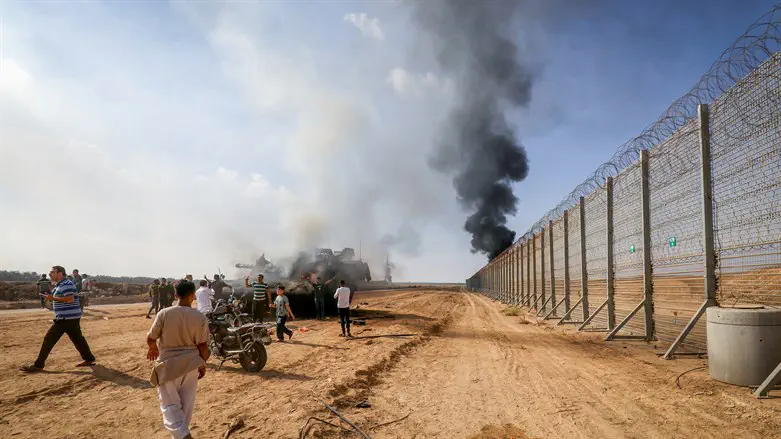
A comprehensive investigation into the battle at the Camp Urim military base during Hamas’ surprise assault on October 7 reveals that the base’s defense system was unprepared for a large-scale infiltration and assault. Eight soldiers and commanders were killed defending the base, with additional troops wounded.
The findings show that Camp Urim was not the terrorists’ original target; they arrived there by mistake en route to attacking a nearby intelligence base. The operational probe reviewed the course of events, combat management, and the conduct of security forces during the infiltration and complex fighting, which took place as Camp Urim became one of dozens of simultaneous attack points.
The unprecedented scale of the infiltration — thousands of terrorists breaching dozens of locations simultaneously, including military installations where the fighting was extensive — was a central reason for the delayed reinforcement to civilian areas and fighting zones.
Base Structure and Initial Readiness
Camp Urim, near Kibbutz Urim and about 16 km from the Gaza border, hosts three units: the Southern District of the Home Front Command, the Border Defense Battalion 414, and an intelligence unit. Each had a standby squad for guard duty. On the morning of the attack, the Home Front Command's standby squad had seven guards, six of them armed.
Timeline of the Attack
At 06:29, Hamas launched a massive rocket barrage at southern Israel and the nation’s interior. Terrorists breached the border fence at dozens of points, using vehicles, motorcycles, and on foot, placing the entire sector under a well-coordinated assault within minutes.
At the onset of the attack, 10 terrorists on 5 motorcycles crossed into Israeli territory and moved toward the Urim military compound. Simultaneously, two female soldiers changing guard shifts at the Southern District base entry post entered a shelter due to incoming rocket alerts (“Red Alert”) and remained there until they were rescued at 12:30 PM. Another soldier entered the weapons storage shelter, while the remaining soldiers at the district base sheltered near the female dorms. The operations room soldier began managing the event, and by 06:36, three additional operators joined. Due to continuing alerts, the duty commander instructed all guards via WhatsApp to remain in protected areas. At 06:42, the district commander ordered all staff to report to the base to manage the rocket fire incidents. Several commanders left their homes, but two were intercepted and wounded by terrorists en route.
Terrorists breach the base
At 07:26, an explosive device was detonated on the fence of the Home Front Command base, breaching the gate and allowing terrorists to infiltrate. Moments later, the operations room soldiers spotted the breach on security cameras and declared a confirmed enemy infiltration, ordering the standby squad to respond immediately. Concurrently, a noncommissioned officer and another operator locked the blast doors at the entrance to the regional command post, where the control room was based.
At 07:29, the standby squad and two operations room soldiers ran from the shelter near the dorms toward the control room. A terrorist squad spotted them and opened fire. Two female soldiers were killed, two others wounded but continued running toward the control room, and the rest retreated to the dorms, some injured. The terrorists proceeded to the weapons storage shelter where a lone soldier was hiding; they shot and killed him. Around the same time, the district operations officer called for the standby squad from the 414th Battalion to assist. The terrorists then entrenched themselves near the weapons shelter to plan their next move.
At 07:33, the district’s training and resources officer arrived unarmed at the main gate. Around this time, power to the base failed, and the gate system became inoperative. The officer left the base and drove to the Dor Alon station at the Urim junction. Meanwhile, the 414th Battalion deployed a drone over the base to locate the terrorists.
At 07:39, a terrorist fired another round at one of the previously fallen female soldiers and stole her weapon. The district commander again ordered all soldiers to regroup at the command post. At 07:44, the 414th Battalion drone located the terrorists.
At 07:49, the terrorist commander split his squad, taking three terrorists toward the female dorms. After setting fire to the duty commander’s car, the terrorists reached the emergency warehouses and opened fire on the doors. During this time, one of the operations room soldiers called out to the terrorists from the command post, demanding they leave the base. Minutes later, the terrorists returned to the weapons shelter to finalize their next attack plan.
At 08:02, the terrorists fired an RPG at the Regional Command Post, hitting the conference room window. They then advanced toward the post and the Human Resources building, shooting at a reservist officer who had arrived at the district gate. The officer was injured and retreated.
At 08:05, the terrorists noticed the main entrance door to the post was left open. They threw a grenade into the entryway and tried to open the first iron door but failed. They continued circling the building, attempting to access the eastern entrance. Inside the command center, a systems NCO stood armed at the doorway to protect the female soldiers.
At 08:14, the terrorists breached the first iron door and entered the reception area. A minute later, they opened the second door and shot the systems NCO, who was killed in action. They tossed a grenade inside the Regional Command Post, but it failed to detonate.
Around 08:15, a force from the 414th Battalion broke through the fence separating the Home Front Command base from the battalion’s base. The force split into three teams and positioned themselves strategically.
At about 08:17, one team, led by the deputy commander of the defense company, took position on the roof of the 'Daniel' Reserve Brigade’s control center, directing the battle from there. The terrorists threw several more grenades into the Regional Command Post while the female soldiers inside took cover. The duty commander handed her weapon to one of the soldiers, and both aimed their rifles at the entrance door. One grenade exploded outside the command room door, but the soldiers were unharmed.
At 08:19, the terrorists entered the Regional Command Post through the second door, shooting out the security cameras. Meanwhile, the district commander arrived at the base perimeter and ran toward the gate with the district’s senior NCO.
At 08:24, the terrorists breached the command room door. The soldiers inside returned fire, but after a brief exchange, the terrorists threw a grenade into the room. The blast disabled all command systems. The terrorists then stormed the room, shooting at the soldiers inside. Three female soldiers were killed, and two others wounded. The terrorists proceeded to search the command post for classified military information and exited at 08:29.
Reinforcements and Final Assault
Simultaneously with the terrorists' breach of the command post, the district commander entered the base through the main gate. A 414th Battalion team positioned near the female soldiers’ quarters mistakenly opened fire on him, but once identified, they ceased fire and the commander joined them.
The team near the quarters and another team on the roof of the 'Daniel' Reserve Brigade control center spotted three terrorists in the fortified shelter near the armory and eliminated them. Around 08:35, another 414th Battalion force entered the district and joined the team.
At approximately 08:37, the deputy district commander arrived at the gate. Again, the team mistakenly identified him as a terrorist and opened fire, but after he was recognized, the district commander instructed him to stay at the gate and control the entry of reinforcements to prevent further friendly fire incidents.
At 08:47, the deputy commander of the defense company, positioned on the rooftop of the Daniel Brigade HQ, identified and eliminated a terrorist hiding behind a blast shelter near the commander’s office.
Between 08:50 and 09:10, two IDF teams identified two more terrorists inside the logistics building. During the battle, the team commander was wounded, and another soldier was wounded and later succumbed to her injuries.
The battle continued. One force eliminated two additional terrorists near the shelter by the commander’s office and located two more terrorists hiding in a nearby shelter. During this time, additional forces arrived to reinforce the fight.
A counter-terrorism school unit breached the eastern fence, an elite Yanmam team entered through an emergency gate, and command teams from the 'Shahar' Battalion and the IDF Ground Forces Training Center entered through the main gate after forcibly opening it due to the power outage.
By 09:45, the Ground Forces Training Center command team joined the district commander, who instructed them to treat the wounded and begin sweeps for additional terrorists.
Around 10:40, the Counter-Terror School unit and Yanmam forces eliminated the last two terrorists hiding in the shelter near the commander's office.
At 10:40, the battle for the base officially ended. Troops began clearing the base and searching for casualties and fallen soldiers. The Yanmam team swept the command center and rescued two injured female soldiers from the control room.
Between 11:30 and 12:30, additional soldiers were rescued by on-site forces and a team from the IDF’s squad commanders' training course.
Between 13:40 and 15:00, a preliminary identification of all fallen soldiers was conducted before evacuation.
Key Findings and Lessons
Defense Concept Deficiency: The defense concept of the base was built around addressing the threat of infiltration, but did not account for the actuality of an infiltration or an attack by such a large number of terrorists. As a result, the guarding forces at the base had never been trained for such a scenario, and existing drills were limited to “case-and-response” formats for small, localized incidents.
Communication and Command Failures: From 07:31, when the first update on the infiltration into the base was received, until the end of the fighting, all updates regarding the enemy’s status were conducted only at the commanders' level and through direct phone calls. No general alert was issued on any platform regarding the terrorists’ infiltration into the base. As a result, during the battle, personnel from the district continued arriving at the base unaware of the ongoing events and without any operational plan.
Manpower Shortage: Only 7 of 12 required security posts were manned; no guards were on duty when the attack began.
The investigation team determined that the base’s defense infrastructure must be significantly improved. The base's defense protocol must be updated to address all potential scenarios, including a defined chain of actions for duty officers in the event of a base infiltration. It was also recommended to increase the number of armed personnel on site and enhance their operational proficiency. Joint drills between the three neighboring units should be intensified to ensure coordinated response in complex incidents. Additionally, the operational coordination between the Home Front Command’s Southern District, the Gaza Division, and the Southern Brigade must be strengthened.
The team also commended the courage of the commanders and female soldiers in the command center, the camaraderie shown by the other soldiers present at the base during the battle, and the determination of the commanders and fighters who engaged the terrorists and assisted in the fighting within the base.
